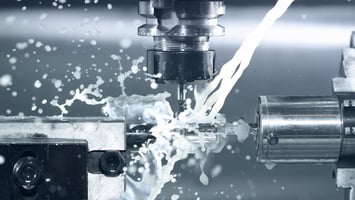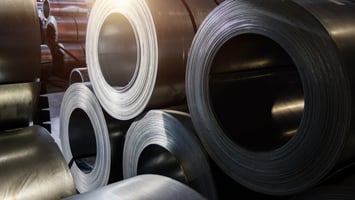Manufacturers looking to find a niche in the metal manufacturing industry can explore the...
Kryton Metals Blog
Evaluating the Pros and Cons of Hand Spinning vs. CNC Spinning

Metal spinning plays a significant role in the metalworking industry, although it is not directly related to CNC machining. As a metalworking process, it combines speed, precision, and efficiency. Many fabrication shops integrate CNC spinning or hand spinning to deliver accurate, cost-effective metal fabrication for various geometries—some fabrication shops even offer both methods.
So, what is CNC metal spinning and how is it different from hand spinning metals? While both are beneficial, they each have a unique list of pros and cons. Professional metallurgy can help modern manufacturers stay ahead of the competitive curve, which is why it is important to understand the differences between these two techniques.
What Is Hand Spinning in Metal Fabrication?
Hand spinning is a metalworking process that involves high speeds and hands-on precision. In this process, machinists attach the workpiece to a vertical or horizontal lathe. Then, they machine the part by hand using various tooling techniques.
While the workpiece spins, an operator can control the speed and forming force to create customized shapes. Experts also rely on their intuition and skill to manipulate the metal structure through subtle hand movements. Often, machinists can use one hand to shape the workpiece and the other one to apply lubricants or adjust the pressure.
DID YOU KNOW: Because hand spinning uses minimal automation, it allows for an infinite number of tailored designs, offering greater flexibility for unique and custom projects.
The Pros and Cons of Hand Spinning Metal Parts
There are several advantages to hand spinning, especially for certain industries. However, hand spun metals may not be the most feasible option for all manufacturers. Let’s dive deeper into the pros and cons of hand spinning metal parts.
Pros:
- Customization: Hand spinning allows for greater flexibility in creating unique and tailored designs, making it ideal for branded products, prototypes, and one-of-a-kind parts.
- Craftsmanship: Skilled machinists can achieve intricate details and precise shaping that may not be possible with automated processes.
- Lower tooling costs: Hand spinning requires fewer specialized tools, which can result in lower upfront costs for small-batch production.
Cons:
- Longer lead times: Hand spinning generally takes more time than automated processes, which can lead to longer production times.
- Higher costs for large-scale production: While hand spinning may be cost-effective for small-batch production, it can become expensive when used for high-volume or mass manufacturing.
- Inconsistency: Since hand spinning relies on the skill and experience of the machinist, there may be inconsistencies between individual parts.
FACT: While machinists may use some automation in hand spinning, the primary focus is on detail and customization rather than meeting high-demand production quotas.
How Does CNC Spinning Work?
CNC spinning, occasionally referred to as automatic spinning, is a metalworking process that utilizes advanced automation for controlling workpieces and cutting tools. This method minimizes operator error, streamlines production, and enables consistently repeatable designs, which contributes to its popularity in modern metal fabrication facilities around the globe.
Machine operators use intuitive software and intelligent input. The system automatically executes commands using predetermined tooling methodologies. As a result, experts can determine the lengths and depths of cuts, but they cannot correct mistakes mid-production as they can with hand spinning. Parts can be fed using a robot arm or even a cobot (collaborative robot) for a more automated process.
DID YOU KNOW: Numerous industries rely on CNC spinning to create identical parts for mass production, adhering to ISO certified methods to ensure consistency and quality.
The Pros and Cons of CNC Spinning Technology
Automatic spinning technologies help manufacturers in several ways. Let’s talk about some pros and cons of CNC spinning technology.
Pros:
- Consistency and repeatability: CNC spinning machines can store and reuse project specifications, ensuring consistent results across multiple production runs.
- Design transferability: Operators can transfer computerized design data from one machine to another, streamlining the production process.
- Efficient production: CNC spinning enables more efficient and rapid metal fabrication compared to hand spinning.
- Greater precision: Machine-assisted tooling can achieve tighter tolerances and improved accuracy in the final product.
Cons:
- Higher initial costs: CNC spinning equipment and software can be expensive, especially for small businesses or those with limited budgets.
- Complexity: Operating CNC spinning machines requires knowledge of both metallurgy and software programming, which can be a steep learning curve for some operators.
- Limited customization: CNC spinning may not be as flexible as hand spinning when it comes to creating unique or custom designs.
FACT: CNC spinning technology can achieve tighter tolerances and greater precision with machine-assisted tooling compared to manual processes.
Hand Spinning or CNC Spinning: Which One Is Better?
The choice between hand spinning and CNC spinning depends on your project's specific requirements and priorities. Each metalworking process has its benefits and drawbacks.
Hand spinning is ideal for intricate designs, custom work, and small-batch orders where a high level of craftsmanship is desired. However, it may not be suitable for large-scale production or situations where identical parts are crucial.
CNC spinning is best for mass manufacturing, where consistency and speed are vital. But it might not be the perfect choice for projects that require exceptional attention to detail or unique customization.
To get the best of both worlds, consider partnering with a facility that offers both CNC and hand spinning services. This approach allows you to take advantage of the benefits of both methods without having to choose between them. Remember that individual craftsmanship still holds value despite advancements in computerized metal fabrication. Embrace the versatility and strengths of both hand spinning and CNC spinning to stay competitive in the market.
Make the Metalworking Process Your Ally
Machining professionals have various options, with both CNC spinning and hand spinning at their disposal. While neither method is perfect, each offers numerous benefits to the shops and clients who utilize them. Additionally, some projects call for even more creative collaboration.
That's why it's essential to have both CNC spinning and hand spinning as available options. Many clients may want to start with automated spinning and then finish with hands-on detailing. Whatever the case, our experts at KRYTON Engineered Metals can determine the most cost-effective approach, considering lead times, tolerances, or materials. Moreover, we provide specialized metal manufacturing services for a wide range of industry sectors, helping to bolster the American economy.
By leveraging the strengths of both CNC spinning and hand spinning, you can make the metalworking process your ally and ensure your projects achieve the desired outcomes.
Contact a metal processing pro at KRYTON to receive more information or to get started.



